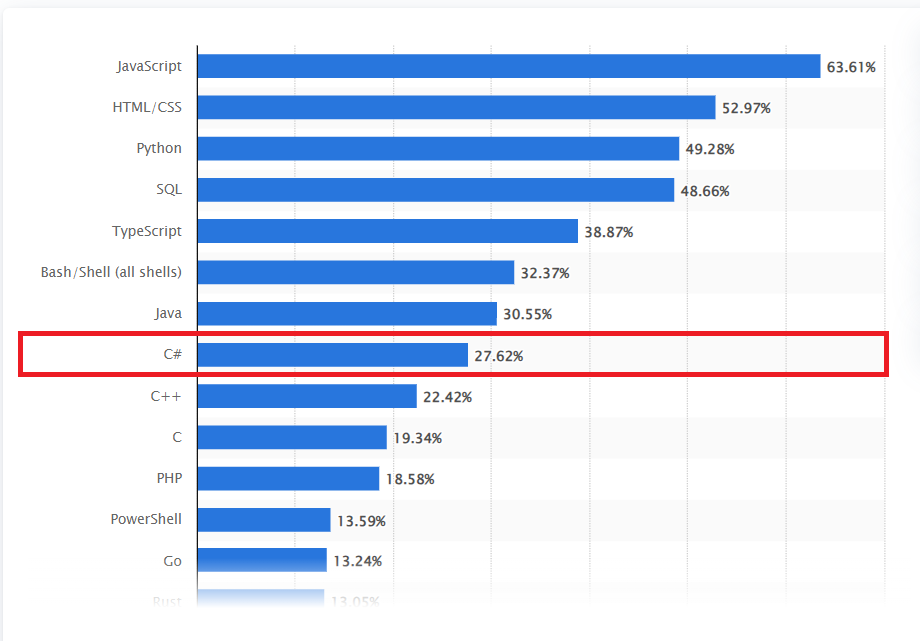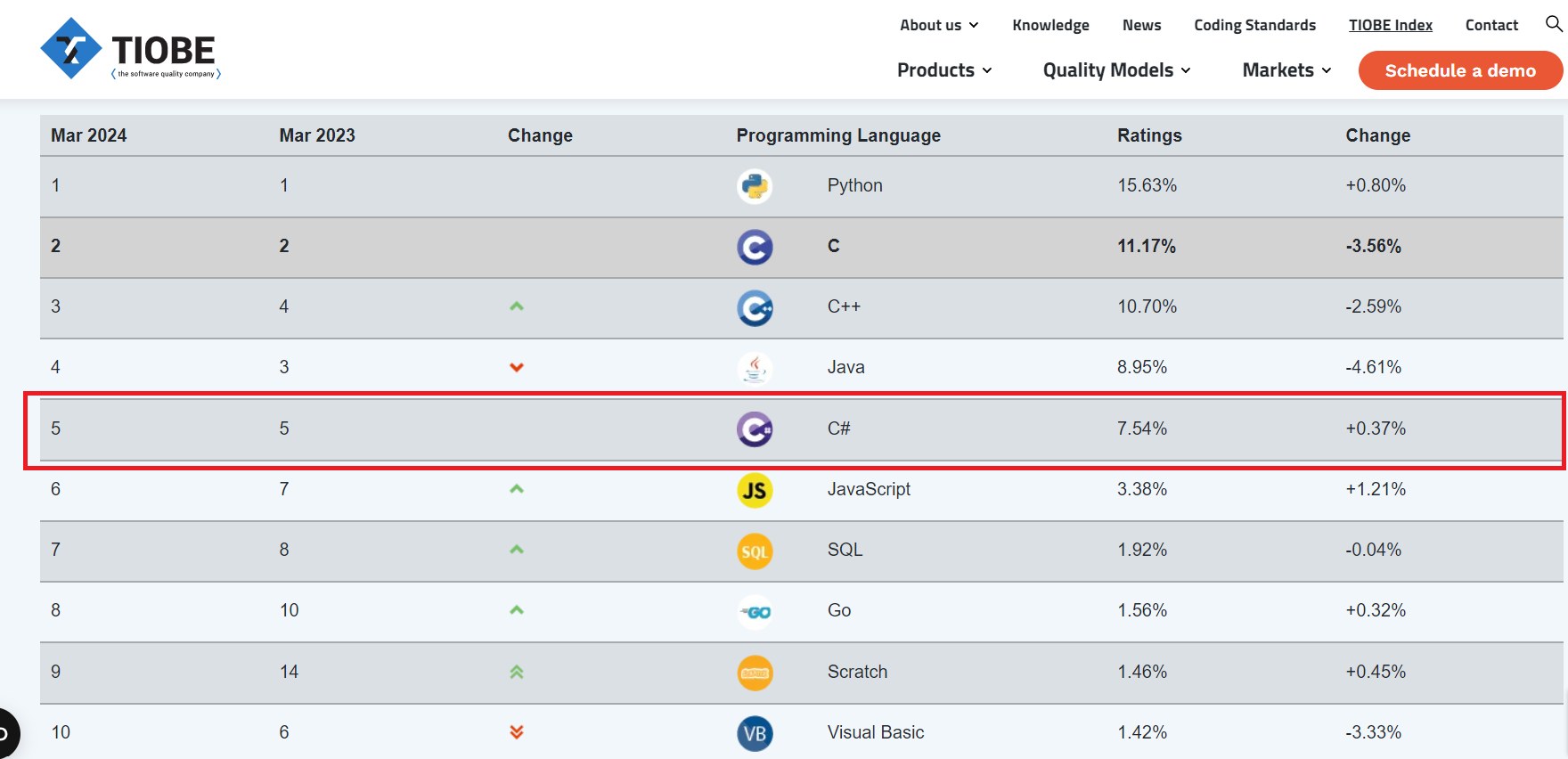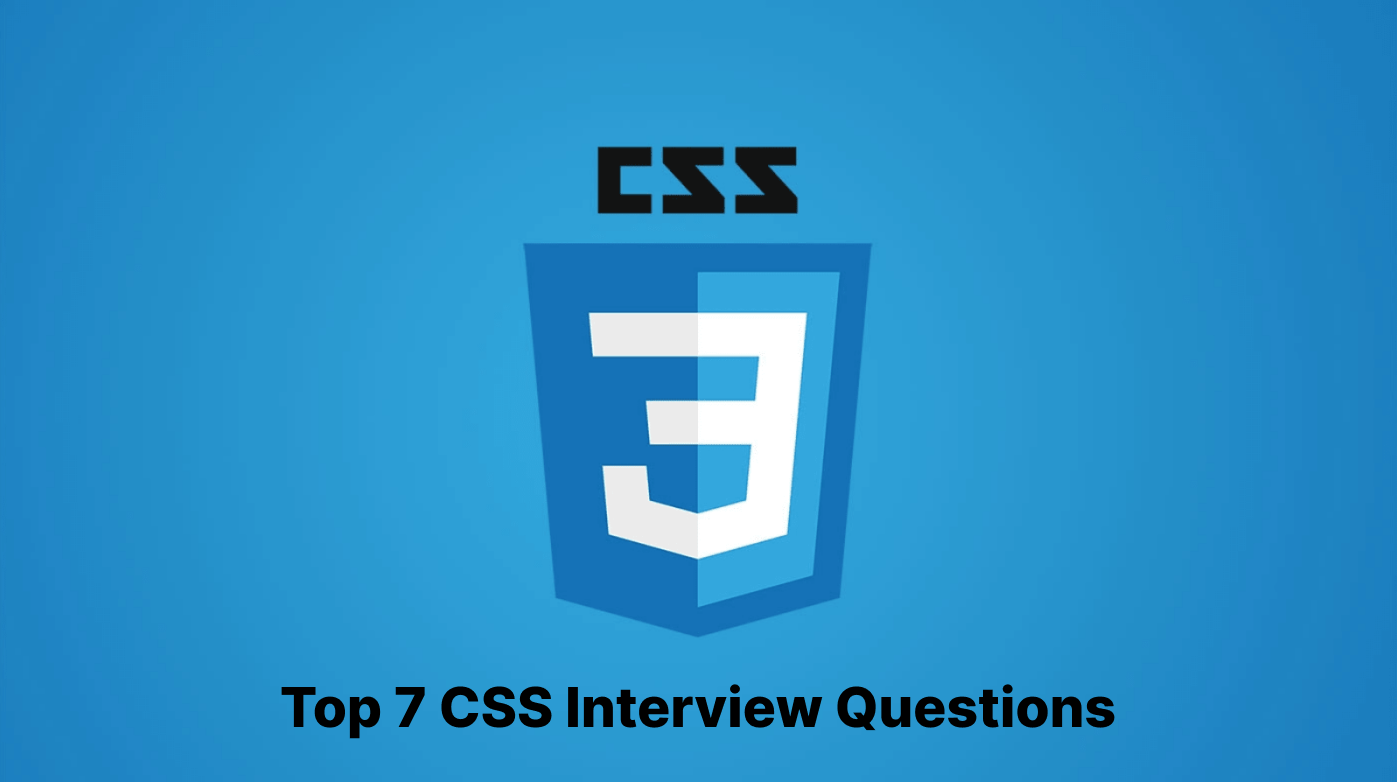Introduction
C# is a versatile, object-oriented programming language developed by Microsoft as part of its .NET initiative. Known for its simplicity, modernity, and suitability for a wide range of applications—from desktop and web applications to game development—C# has become one of the top choices for developers worldwide.
According to Statista, C# is the 7th most-used programming language among developers worldwide in 2024. This statistic shows the broad adoption and versatility of C#, highlighting its importance in the current software development landscape.

This article is designed to guide technical hiring managers through effectively structuring their technical interviews. We will explore the 10 must-ask C# interview questions that are essential for assessing software engineers.
These C# interview questions are about testing knowledge and are carefully chosen to help hiring managers and technical recruiters identify talented individuals who can contribute significantly to their projects and organizations.
What is C# Programming?
C# is a modern, object-oriented programming language developed by Microsoft as part of its .NET initiative in 2000. Designed to be simple, powerful, and versatile, C# enables developers to build a wide range of applications, including web, desktop, and mobile apps. Its syntax is similar to other C-style languages, such as C and C++, making it accessible for newcomers and familiar for experienced programmers.
According to the TIOBE Index, C# is the 5th most popular programming language in the world in 2024. This ranking reflects its widespread adoption and the robust community of developers leveraging its capabilities for many software development projects.

History
C# was introduced by Microsoft in 2000, and its development was led by Anders Hejlsberg. The language was conceived as part of Microsoft’s .NET framework initiative, aiming to combine the computing power of C++ with the ease of use seen in VB (Visual Basic).
Since its inception, C# has gone through numerous versions, adding new features and improvements to support modern software development needs, including dynamic language features, asynchronous programming models, and more comprehensive data query capabilities.
Key Features
- Object-Oriented: Everything in C# is associated with objects and classes, promoting a clear structure for programs and facilitating code reuse and maintainability.
- Type-Safe: C# ensures type-safety, meaning it checks the type of data being used in the operations during compile time, reducing errors and exceptions at runtime.
- Interoperable: Through the .NET framework, C# can call upon code written in other languages, making it highly versatile in multi-language development environments.
- Scalable and Updateable: C# applications are easy to update and scale, making the language suitable for applications of any size, from small to large enterprise solutions.
- Component Oriented: C# supports component-oriented programming, a design philosophy that promotes the separation of concerns, increasing application maintainability and extensibility.
C# Coding Examples
To illustrate some of C#’s capabilities, consider the following simple examples:
Example 1: Hello World
| using System;
class Program { static void Main() { Console.WriteLine(“Hello, World!”); } } |
This program prints “Hello, World!” to the console, demonstrating C#’s simplicity for beginners.
Example 2: Basic Class and Object
| using System;
public class Book { public string title; public string author; public void DisplayInfo() { Console.WriteLine($”Title: {title}, Author: {author}”); } } class Program { static void Main() { Book myBook = new Book(); myBook.title = “C# Programming”; myBook.author = “Jane Doe”; myBook.DisplayInfo(); } } |
This example introduces a Book class with properties and a method, then creates an instance of the class and uses it, highlighting C#’s object-oriented nature.
Popular Companies Using C#
- Microsoft: As the creator of C#, Microsoft uses the language extensively across its applications and services, including Windows, Office, and Visual Studio.
- Stack Overflow: A popular community and forum for developers, Stack Overflow employs C# for its web back end to handle millions of user queries and interactions.
- GoDaddy: The internet domain registrar and web hosting company utilizes C# for its website and a range of online services.
- Accenture: A global professional services company, Accenture uses C# in many of its custom software development and client solutions.
- Epic Systems: A leading company in healthcare software, Epic Systems uses C# to develop various applications for hospitals and healthcare organizations.
- Alibaba Group: The Chinese multinational conglomerate in the e-commerce, retail, and technology sectors uses C# for backend services on some of its platforms.
- Dell: The multinational computer technology company uses C# to develop system management and monitoring applications.
- NASA: The National Aeronautics and Space Administration uses C#, among other languages, for developing simulation and modeling software.
10 Must Ask C# Interview Questions
Let’s explore the top C# interview questions:
1. Implement a Function to Reverse a String in C#
| Task | Write a function in C# that reverses a given string. The function should take a string as input and return the reversed string as output. |
| Input Format | A single line containing the string s. |
| Constraints |
|
| Output Format | A single line containing the reversed string. |
| Sample Input | hello |
| Output | olleh |
Suggested Answer
| public static string ReverseString(string s)
{ char[] charArray = s.ToCharArray(); Array.Reverse(charArray); return new string(charArray); } |
Code Explanation
The function ReverseString converts the input string s into a character array using ToCharArray(). It then uses Array.Reverse() to reverse the array in place. Finally, it constructs a new string from the reversed array and returns it.
| Common Mistakes to Watch Out For |
|
| Follow-ups |
|
| What the Question Tests | This question assesses the candidate’s understanding of string manipulation in C#, array handling, and the concept of immutability in C#. It also tests the candidate’s ability to think of alternative solutions and optimizations, reflecting their problem-solving skills and efficiency in code writing. |
2. Calculate the Sum of Numbers in an Array
| Task | Write a C# method that calculates the sum of an array of integers. The method should take an array of integers as input and return the sum of its elements. |
| Input Format | An array of integers, arr. |
| Constraints |
|
| Output Format | An integer representing the sum of the elements in the array. |
| Sample Input | [1, 2, 3, 4, 5] |
| Output | 15 |
Suggested Answer
| public static int SumArray(int[] arr)
{ int sum = 0; for (int i = 0; i < arr.Length; i++) { sum += arr[i]; } return sum; } |
Code Explanation
This method, SumArray, initializes a sum variable to 0. It then iterates through each element of the input array arr, adding each element’s value to sum. After completing the iteration, it returns the total sum.
| Common Mistakes to Watch Out For |
|
| Follow-ups |
|
| What the Question Tests | This question evaluates the candidate’s familiarity with basic C# syntax and operations, such as looping through an array and summing up its elements. It also tests their ability to consider edge cases, like integer overflow, and their knowledge of C# features like LINQ for more elegant solutions. |
3. Check for Palindrome String
| Task | Write a C# method to check if a given string is a palindrome. A palindrome is a word, phrase, number, or other sequences of characters that reads the same forward and backward (ignoring spaces, punctuation, and capitalization). |
| Input Format | A single string, s. |
| Constraints |
|
| Output Format | A boolean value: true if the string is a palindrome; otherwise, false. |
| Sample Input | “A man, a plan, a canal: Panama” |
| Output | true |
Suggested Answer
| public static bool IsPalindrome(string s)
{ s = s.ToLower(); int left = 0, right = s.Length – 1; while (left < right) { if (!char.IsLetterOrDigit(s[left])) left++; else if (!char.IsLetterOrDigit(s[right])) right–; else if (s[left] != s[right]) return false; else { left++; right–; } } return true; } |
Code Explanation
The method IsPalindrome first converts the input string s to lowercase to make the comparison case-insensitive. It then uses two pointers, left and right, to compare characters from the beginning and the end of the string, moving towards the center.
It skips non-alphanumeric characters and checks for character equality. If it finds a mismatch, it returns false. If the pointers cross without finding a mismatch, the string is a palindrome, and it returns true.
| Common Mistakes to Watch Out For |
|
| Follow-ups |
|
| What the Question Tests | This question assesses the candidate’s ability to manipulate strings, handle edge cases, and apply logical thinking. It tests understanding of string preprocessing, iteration, and character comparison, essential skills for solving problems involving text analysis. |
4. Find the Missing Number in a Sequence
| Task | Write a C# method that finds the missing number in a given sequence of numbers from 1 to n. The sequence is represented by an array of integers and contains all numbers from 1 to n except one missing number. Your method should return the missing number. |
| Input Format | An array of integers, arr, representing the sequence. |
| Constraints |
|
| Output Format | An integer representing the missing number in the sequence. |
| Sample Input | [3, 7, 1, 2, 8, 4, 5] |
| Output | 6 |
Suggested Answer
| public static int FindMissingNumber(int[] arr)
{ int n = arr.Length + 1; int totalSum = n * (n + 1) / 2; int arraySum = 0; for (int i = 0; i < arr.Length; i++) { arraySum += arr[i]; } return totalSum – arraySum; } |
Code Explanation
This method calculates the missing number by first determining what the total sum of all numbers from 1 to n should be, using the formula n * (n + 1) / 2. It then calculates the sum of the numbers present in the array. The difference between these two sums is the missing number, which the method returns.
| Common Mistakes to Watch Out For |
|
| Follow-ups |
|
| What the Question Tests | This question evaluates the candidate’s ability to work with mathematical formulas and arrays. It tests their understanding of arithmetic sequences and their ability to apply this knowledge to solve problems efficiently. |
5. Merge Two Sorted Arrays
| Task | Write a C# method that merges two sorted arrays of integers into a single sorted array. The method should take two arrays of integers, both sorted in ascending order, as input and return a new array containing all elements from both arrays, also sorted in ascending order. |
| Input Format |
|
| Constraints |
|
| Output Format | An array of integers sorted in ascending order, containing all elements from both arr1 and arr2. |
| Sample Input | arr1 = [1, 3, 5]
arr2 = [2, 4, 6] |
| Output | [1, 2, 3, 4, 5, 6] |
Suggested Answer
| public static int[] MergeSortedArrays(int[] arr1, int[] arr2)
{ int[] result = new int[arr1.Length + arr2.Length]; int i = 0, j = 0, k = 0; while (i < arr1.Length && j < arr2.Length) { if (arr1[i] < arr2[j]) { result[k++] = arr1[i++]; } else { result[k++] = arr2[j++]; } } while (i < arr1.Length) { result[k++] = arr1[i++]; } while (j < arr2.Length) { result[k++] = arr2[j++]; } return result; } |
Code Explanation
The method MergeSortedArrays initializes a result array of size equal to the sum of the lengths of arr1 and arr2. It then iterates through both input arrays simultaneously, comparing their current elements and adding the smaller one to the result array.
This process continues until all elements from both arrays have been added to the result array, ensuring the merged array is sorted.
| Common Mistakes to Watch Out For |
|
| Follow-ups |
|
| What the Question Tests | This question assesses the candidate’s understanding of array manipulation, specifically their ability to merge sorted arrays. It tests their ability to handle multiple pointers and edge cases, such as uneven array lengths. |
6. Rotate an Array
| Task | Write a C# method that rotates an array to the right by a given number of steps. Each step means that the last element of the array becomes the first one. The method should take an array of integers and the number of steps as input, and modify the array in place to achieve the rotation. |
| Input Format |
|
| Constraints |
|
| Output Format | The method does not return a value. Instead, it modifies the input array arr in place. |
| Sample Input | arr = [1, 2, 3, 4, 5], steps = 2 |
| Output | arr = [4, 5, 1, 2, 3] |
Suggested Answer
| public static void RotateArray(int[] arr, int steps)
{ int length = arr.Length; steps = steps % length; // In case steps is greater than array length Reverse(arr, 0, length – 1); Reverse(arr, 0, steps – 1); Reverse(arr, steps, length – 1); } private static void Reverse(int[] arr, int start, int end) { while (start < end) { int temp = arr[start]; arr[start] = arr[end]; arr[end] = temp; start++; end–; } } |
Code Explanation
This method first normalizes the steps to ensure it’s within the array’s length, then reverses the entire array. It then reverses the first steps elements to position them correctly, followed by reversing the rest of the array. This sequence of reversals effectively rotates the array to the right by the specified number of steps.
| Common Mistakes to Watch Out For |
|
| Follow-ups |
|
| What the Question Tests | This question examines the candidate’s ability to manipulate arrays, particularly their understanding of in-place operations. It tests their knowledge of algorithmic techniques, like using reversals to achieve rotation, and their ability to optimize to handle larger inputs efficiently. |
7. Implement a Stack Using Arrays
| Task | Write a C# class that implements a stack using arrays. Your implementation should include:
Implement a method to retrieve the top element of the stack without removing it. |
| Input Format |
|
| Constraints |
|
| Output Format |
|
Sample Usage
| Stack stack = new Stack();
stack.Push(1); stack.Push(2); Console.WriteLine(stack.Peek()); // Output: 2 Console.WriteLine(stack.Pop()); // Output: 2 Console.WriteLine(stack.IsEmpty()); // Output: False |
Suggested Answer
| public class Stack
{ private int[] elements; private int size; public Stack() { elements = new int[10000]; // Maximum size as per constraints size = 0; } public void Push(int item) { elements[size] = item; size++; } public int Pop() { if (IsEmpty()) { throw new InvalidOperationException(“Stack is empty”); } size–; return elements[size]; } public int Peek() { if (IsEmpty()) { throw new InvalidOperationException(“Stack is empty”); } return elements[size – 1]; } public bool IsEmpty() { return size == 0; } } |
Code Explanation
The class Stack uses an array elements to store the stack’s items and an integer size to track the number of items in the stack. The Push method adds an item to the top of the stack. The Pop method removes and returns the top item, throwing an exception if the stack is empty.
The Peek method returns the top item without removing it, also throwing an exception if the stack is empty. The IsEmpty method returns true if the stack is empty and false otherwise.
| Common Mistakes to Watch Out For |
|
| Follow-ups |
|
| What the Question Tests | This question assesses the candidate’s understanding of the stack data structure and their ability to implement it using arrays. It tests their knowledge of basic operations associated with stacks (push, pop, peek, isEmpty) and their ability to handle edge cases, such as popping from an empty stack. |
8. Calculate Fibonacci Numbers Using Recursion
| Task | Write a C# method that calculates the nth Fibonacci number using recursion. The Fibonacci sequence is a series of numbers where each number is the sum of the two preceding ones, usually starting with 0 and 1. |
| Input Format | A single integer, n, representing the position in the Fibonacci sequence. |
| Constraints |
|
| Output Format | An integer representing the nth Fibonacci number. |
| Sample Input | 5 |
| Output | 5 |
Suggested Answer
| public static int Fibonacci(int n)
{ if (n <= 1) { return n; } else { return Fibonacci(n – 1) + Fibonacci(n – 2); } } |
Code Explanation
This method follows the definition of the Fibonacci sequence: the base cases are when n is 0 or 1, in which case the method returns n itself. For all other values of n, the method recursively calls itself to calculate the sum of the two preceding numbers in the sequence, thereby computing the nth Fibonacci number.
| Common Mistakes to Watch Out For |
|
| Follow-ups |
|
| What the Question Tests | This question evaluates the candidate’s understanding of recursion, a fundamental programming concept, and their ability to apply it to solve problems. It tests their knowledge of the Fibonacci sequence and their ability to identify and implement base cases in recursive algorithms. |
9. Implement Binary Search on a Sorted Array
| Task | Write a C# method to perform a binary search on a sorted array of integers. The method should take an array of integers and a target integer to search for within the array. If the target is found, return its index in the array; if not found, return -1. |
| Input Format |
|
| Constraints |
|
| Output Format | An integer representing the index of the target in arr if found; otherwise, -1. |
| Sample Input | arr = [1, 2, 3, 4, 5], target = 3 |
| Output | 2 |
Suggested Answer
| public static int BinarySearch(int[] arr, int target)
{ int low = 0; int high = arr.Length – 1; while (low <= high) { int mid = low + (high – low) / 2; if (arr[mid] == target) { return mid; } else if (arr[mid] < target) { low = mid + 1; } else { high = mid – 1; } } return -1; } |
Code Explanation
This method implements the binary search algorithm. It starts by defining two pointers, low and high, which represent the current search range within the array. The method then enters a loop that continues as long as low is less than or equal to high. Inside the loop, it calculates the middle index, mid, and compares the element at mid with the target.
If the element matches the target, its index is returned. If the element is less than the target, the search continues in the right half of the array, so low is adjusted. If the element is greater, the search continues in the left half, so high is adjusted. If the loop completes without finding the target, the method returns -1.
| Common Mistakes to Watch Out For |
|
| Follow-ups |
|
| What the Question Tests | This question tests the candidate’s understanding of binary search, a fundamental algorithm in computer science known for its efficiency in searching sorted data. It assesses the candidate’s ability to implement algorithms, handle edge cases, and optimize search operations. |
10. Find All Duplicates in an Array
| Task | Write a C# method to find all the duplicate numbers in a given array of integers. The method should return a list of integers that appear more than once in the array. The array may contain multiple duplicates, but the returned list should include each duplicate number only once. |
| Input Format | An array of integers, arr. |
| Constraints |
|
| Output Format | A list of integers representing the numbers that appear more than once in the array. |
| Sample Input | [4, 3, 2, 7, 8, 2, 3, 1] |
| Output | [2, 3] |
Suggested Answer
| public static List<int> FindDuplicates(int[] arr)
{ var duplicates = new HashSet<int>(); var seen = new HashSet<int>(); foreach (var num in arr) { if (seen.Contains(num)) { duplicates.Add(num); } else { seen.Add(num); } } return duplicates.ToList(); } |
Code Explanation
This method uses two hash sets: seen to track numbers already encountered in the array and duplicates to store numbers that appear more than once. It iterates through each number in the array. If a number is in the seen set, it’s added to the duplicates set.
Otherwise, it’s added to seen. Finally, the method converts the duplicates set to a list and returns it, ensuring each duplicate number is included only once.
| Common Mistakes to Watch Out For |
|
| Follow-ups |
|
| What the Question Tests | This question examines the candidate’s ability to work with arrays and sets, showcasing their understanding of data structures and their applications. It assesses their capability to efficiently track and identify duplicates within a collection. |
Conclusion
Throughout this article, we’ve explored a range of essential C# interview questions designed to assist hiring managers in identifying the most qualified software developer candidates. From basic string manipulation and data structure handling to more complex tasks like algorithm optimization and system design, these questions are crafted to test candidates on practical skills that are important for any C# developer.
We encourage hiring managers and technical recruiters to leverage platforms like Interview Zen. Interview Zen streamlines the technical assessment process, making it more efficient and effective.
This platform enables you to create comprehensive, code-based interviews and evaluate candidates’ coding skills, logical reasoning, and technical knowledge in a real-world context.
By integrating these questions into your interviews and utilizing platforms like Interview Zen, you can enhance your ability to discover talented developers who can drive innovation and growth for your organization.




